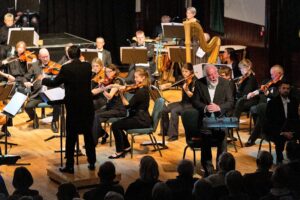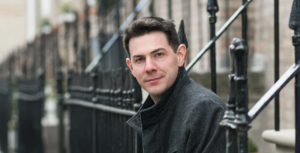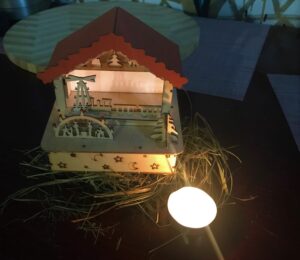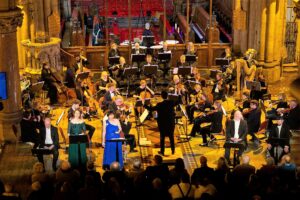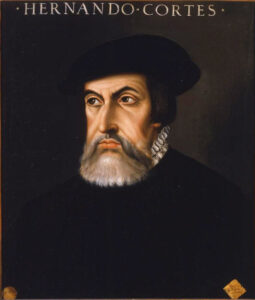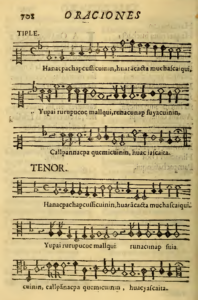Jeśli nawet Offenbach nie obejrzał na scenie Les contes fantastiques d’Hoffmann Jules’a Barbiera i Michela Carré – co raczej mało prawdopodobne, bo paryżanie po udanej premierze sztuki w 1851 roku pchali się do Théâtre de l’Odéon drzwiami i oknami – z pewnością o niej usłyszał. Na pomysł luźnej adaptacji trzech opowiadań E. T. A. Hoffmanna (Piaskuna, Radcy Krespela i Przygody w noc sylwestrową) wpadli obydwaj autorzy. Genialna intuicja podpowiedziała Barbierowi, żeby wprowadzić w narrację samego Hoffmana i uczynić go głównym bohaterem tej kalejdoskopowej historii o miłości i innych demonach. Kilkanaście lat później dramat doczekał się przeróbki na libretto niedoszłej opery Héctora Salomona. Offenbach okazał poważne zainteresowanie tym tekstem dopiero po wojnie francusko-pruskiej, kiedy musiał zbudować swą paryską karierę właściwie od nowa. Opracowaniem libretta zajął się już tylko Barbier – Carré umarł przedwcześnie w 1872 roku. Gdyby nie splot pechowych okoliczności, niewykluczone, że Offenbach wziąłby się ostro do roboty i wystawił swoją „prawdziwą” operę zgodnie z pierwotnym planem, w sezonie 1877/78.
Tymczasem dopiero wówczas zabrał się na dobre do komponowania. Udana podróż do Stanów Zjednoczonych przysporzyła mu znacznych korzyści finansowych, dzięki czemu nareszcie mógł spłacić długi i wrócić do rzuconych w kąt partytur. Niestety, dokuczliwa podagra, której nabawił się w czasach prosperity, odbierała mu siły coraz zachłanniej. Pisząc Opowieści Hoffmanna, Offenbach wiedział już, że umiera. Budził się po nocach tak umęczony chorobą, że nawet dotyk prześcieradła sprawiał mu nieznośny ból. Za dnia szukał pocieszenia w rozmowach z psem – zapewne brzydkim i podłej postury, skoro nazwał go imieniem Kleinzacha, karła z piosenki w prologu opery. Wyznał mu ponoć, że oddałby wszystko, żeby dożyć premiery utworu. Zabrakło czterech miesięcy. Opowieści Hoffmanna, zorkiestrowane i uzupełnione recytatywami przez Ernesta Guirauda, pocięte i złożone od nowa przez Léona Carvalho, ówczesnego dyrektora Opéra-Comique, trafiły na scenę w lutym 1881 roku i z miejsca odniosły tryumf. Dziś są najczęściej wystawianym dziełem Offenbacha, a zarazem dziełem wciąż otwartym, mimo odkryć muzykologicznych z minionych dekad właściwie niemożliwym do zrekonstruowania zgodnie z zamysłem kompozytora.
W ostatnich sezonach Opowieści grywa się najczęściej w wersji opracowanej wspólnie przez Michaela Kaye’a i Jean-Christophe’a Kecka, jak dotąd najbardziej spójnej dramaturgicznie. I w tym właśnie kształcie opera doczekała się najświeższej premiery w Göteborgsoperan, zrealizowanej w koprodukcji z Saarländisches Staatstheater Saarbrücken, pod dyrekcją muzyczną Sébastiena Roulanda i w reżyserii Krystiana Lady. Scenografię przygotował Marian Nketiah, absolwent wydziału architektury Technische Universität Berlin, kostiumy – Bente Rolandsdotter, której projekty wychwalałam już przy okazji Il ritorno d’Ulisse w Bazylei, niezwykle istotną w tym przedstawieniu reżyserią świateł zajął się Aleksandr Prowaliński, członek ekipy polskiego reżysera przy inscenizacji opery Florencia en el Amazonas Daniela Catána w Theater St. Gallen.
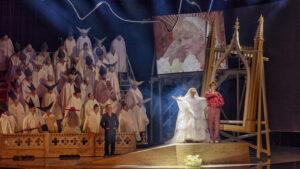
Opowieści Hoffmanna w Göteborgsoperan. Tomas Lind (Spalanzani), Kerstin Avemo (Olimpia) i Brian Michael Moore (młody Hoffmann). Fot. Lennart Sjöberg
O ile powierzanie czterech głównych partii kobiecych Opowieści jednej śpiewaczce (zgodnie z intencją Offenbacha) staje się praktyką dominującą w większości teatrów, o tyle na pomysł, żeby w roli Hoffmanna obsadzić trzech wykonawców, wpadł do tej pory chyba tylko Barrie Kosky w swoim berlińskim przedstawieniu z 2015 roku. Zrealizował go zresztą innymi środkami i w całkiem innym celu niż Krystian Lada, który zdecydował się na analogiczny manewr w Göteborgu. U Lady głównym protagonistą jest Hoffmann w wieku średnim – poeta, pisarz, artysta przeżywający gwałtowny kryzys po rozstaniu z kobietą swego życia. Zamknięty w czterech ścianach żałośnie opustoszałego mieszkania, chleje na umór, rozpacza, zmaga się z ciągiem halucynacyjnych obrazów, w których on sam – i jego ukochana Stella – jawią się jako postaci z przeszłości, bohaterowie całkiem niedawnych zdarzeń i prefiguracje osób, którymi mogą stać się w przyszłości. W tej na poły faustowskiej, na poły freudowskiej wędrówce w głąb własnej psychiki towarzyszy mu mnóstwo figur pobocznych oraz dwie figury zasadnicze: miłości prawdziwej, wymagającej wyrzeczeń, prowadzącej jednak do prawdziwej wolności – reprezentowanej przez Muzę utożsamioną z Niklausem (też poniekąd w zgodzie z zamysłem kompozytora) oraz przez cztery wcielenia mefistofelesowskiej siły, która „jest częścią tej ciemności, co światło stworzyła”. Opowieści Hoffmanna w tym ujęciu są nie tylko opisem trzech etapów z życia mężczyzny, ale też historią o dojrzewaniu: fantastyczną baśnią o coraz mądrzejszym księciu, który z wolna zdaje sobie sprawę, ile zła wyrządził księżniczkom, które i jego skrzywdziły. Mężczyźnie, który musi zmierzyć się z własnym ego, stawić czoło czterem demonom, które „ciągle przeczą” i wystawiają go na próbę, zrozumieć, że czasem trzeba przestać istnieć, żeby znów stać się człowiekiem – nie tylko poetą.
W szwedzkim spektaklu Hoffmann obserwuje się z zewnątrz, kłóci się sam ze sobą, wciela się w siebie z przeszłości i wyobrażonego siebie u kresu życia. Dlatego, choć w przedstawieniu prym wiedzie Hoffmann „średni”, protagonista często przemawia głosami pozostałych dwóch wcieleń, a czasem nawet śpiewa razem z nimi. Utożsamia się też z wyszydzanym Kleinzachem (stąd jego balladzie towarzyszy przejmująca pantomima z udziałem dręczonego przez rówieśników młodego Hoffmana) i dostrzega rys swej osobowości w postaciach, które do tej pory obwiniał o swoje nieszczęście (znakomity pomysł, żeby rolę Spalanzaniego obsadzić tym samym śpiewakiem, któremu powierzono partię starego Hoffmanna).
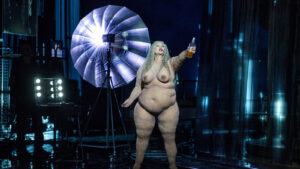
Katarina Karnéus (Muza/Niklaus). Fot. Lennart Sjöberg
Taka interpretacja, przedziwnie zgodna z intencjami twórców opery, wymaga ogromnej precyzji i konsekwencji od wszystkich realizatorów przedsięwzięcia. Udało się, co tym bardziej godne podziwu, że Opowieści Hoffmanna nastręczają kłopotów właściwie wszystkim inscenizatorom tego arcydzieła, a w przypadku Krystiana Lady były pierwszym zakrojonym na taką skalę projektem od czasów pamiętnego Nabucca w Operze Wrocławskiej. Lada wykorzystał bardzo szeroką paletę środków teatralnych, włącznie z projekcjami nagranych wcześniej filmów i dość intensywnym użyciem sceny obrotowej. Przyznam, że w Prologu czułam się wręcz przytłoczona tą obfitością: wędrówkę przez gąszcz archetypów i symboli ułatwiła mi Bente Rolandsdotter i jej „mówiące” kostiumy, z pozoru surrealistyczne, w istocie pomagające zrozumieć, kto jest kim w świecie malowanych jaskrawymi barwami wrażliwców, z drugiej zaś strony groteskowych brutali, wtłoczonych w uprzęże BDSM. Akt Olimpii – zamiast rozegrać się w Paryżu – „zatrzymał” się w mieszczańskiej Norymberdze, w scenerii fenomenalnie zaaranżowanej przez Nketiaha, rodem jak z Wagnerowskich Śpiewaków. Monachijski w zamyśle akt Antonii toczył się w przestrzeni skrajnie intymnej, kształtowanej światłem i gestem, wzbudzającej skojarzenia z dowolnym miejscem w Europie, gdzie ludziom dzieje się krzywda za zamkniętymi drzwiami bogatych domów. Akt Giulietty pulsował blaskiem diamentu z arii Dapertutta i nieubłaganym rytmem gier w weneckim kasynie. Nic tu nie było współczesne i nic nie było z epoki. Hoffman zapijał się na śmierć w szlafroku, który wyglądał jak żałosne wspomnienie jego kwiecistej koszuli z młodości. Przerażona i jak najbardziej żywa Olimpia – niby żywcem zdjęta z ludowego obrazu Madonny – przywodziła na myśl słowa Kleista, który utrzymywał, że wdzięk doskonały może być atrybutem albo mechanicznej lalki, albo samego Boga. Osłupiająco bujne kształty Muzy kojarzyły się z archetypem odwiecznej kobiecości – odsyłając nie tylko do Junga, ale też do Słowackiego i jego śnionego w dzieciństwie snu, który determinuje całe nasze dorosłe życie. Koncepcja płynnej tożsamości Lindorfa/Coppeliusa/Mirakla/Dapertutta celnie trafiła w ideę wielorakości obecnego w nas zła.
Jest w tym spektaklu kilka tropów polskich, między innymi wątek Olimpii ukazanej jako ofiara przemocowego, opętanego religią społeczeństwa, które próbuje wtłoczyć kobietę w rolę uległej, bezmyślnej lalki. Jest kilka etiud złożonych w hołdzie Offenbachowi, który chciał, żeby widownia wybuchała śmiechem z ulgi, nie mogąc znieść nadmiaru zawartych w dziele emocji. Jest kilka scen pamiętnych: odejście Olimpii, symboliczna śmierć Antonii, chwila, w której stary Hoffmann uświadamia sobie, że zabiwszy Schlemila, zabił w istocie sam siebie.
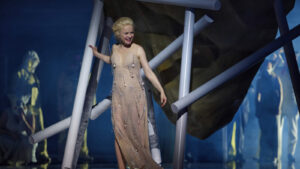
Kerstin Avemo (Giulietta). Fot. Lennart Sjöberg
Koncepcja Lady zyskała wyśmienitych odtwórców w osobach śpiewaków, zwłaszcza fenomenalnej aktorsko Kerstin Avemo, obdarzonej sopranem niedużym, lecz wyjątkowo sprawnym i umiejętnie balansującym w obrębie stylów, które Offenbach uczynił przedmiotem swojej przewrotnej gry z konwencją. Z trzech obsadzonych w przedstawieniu Hoffmannów najwięcej do roboty miał Joachim Bäckström, dysponujący typowym młodzieńczym Heldentenorem, pięknym w barwie, choć wciąż jeszcze niedostatecznie zniuansowanym do tej trudnej partii. W roli młodego Hoffmanna nieźle sprawił się amerykański tenor liryczny Brian Michael Moore, muszę jednak przyznać, że spośród trzech wcieleń protagonisty największe wrażenie zrobił na mnie Tomas Lind – Hoffmann przekonujący tyleż wokalnie, co postaciowo, zapadający w serce i ucho jako najwiarygodniejsze uosobienie artysty w kryzysie wieku, a zarazem przykład nieprzemijającego piękna dobrze prowadzonego i mądrze pielęgnowanego głosu. W spektaklu 9 grudnia niedysponowaną Katarinę Karnéus (Muza/Niklaus) godnie zastąpiła śpiewająca z kulis Ann-Kristin Jones. W poczwórnej roli Lindorfa/Coppeliusa/Mirakla/Dapertutta wystąpił Andrew Foster-Williams, potwierdzając klasę nie tylko jako znakomity odtwórca partii przeznaczonych na specyficznie „francuski” głos basowy, ale też świetny, obdarzony wyjątkowym poczuciem humoru aktor. Spośród odtwórców ról charakterystycznych na szczególną wzmiankę zasłużył Daniel Ralphsson (Andrès/Cochenille/Frantz/Pitichinaccio), zwłaszcza w prześmiesznej interpretacji „Jour et nuit je mets en quarte”, dowodu muzycznej głuchoty służącego Frantza, podanego w tym przedstawieniu przez szeregowego z pozoru technika, pałętającego się na scenie od początku spektaklu.
Całość z niesłychaną werwą i wyczuciem stylu poprowadził Sébastien Rouland, artysta znany także polskim melomanom, uczeń Marca Minkowskiego i dyrygent La vie parisienne Offenbacha w ujęciu przygotowanym pod jego dyrekcją w Opéra National de Lyon i wydanym na płytach DVD przez wytwórnię Virgin Classics. „Cóż to wyziera z onego zwierciadła”, żeby zacytować końcówkę Przygody w noc sylwestrową E. T. A. Hoffmanna? Ano tyle, żeby traktować koprodukcje jako spójną od początku wizję artystyczną, realizowaną pod batutą dyrygenta znającego się na rzeczy, ze świadomymi swych powinności śpiewakami, w ujęciu reżysera, który umie czytać partyturę. Tymczasem w Polsce nic z tego nie wychodzi. Czekam na koniec powieści o utraconym odbiciu – który za sprawą oddanych sprawie realizatorów przeistoczy się wreszcie w nowy początek.




